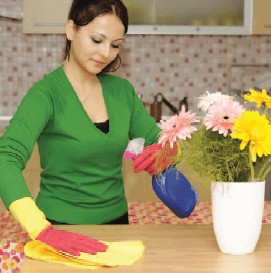Germs – Surprising places they hide

When it comes to avoiding germs, your smart phone may not be so smart. Experts say cell phones are hot spots for bacteria growth. As we head into the height of cold and flu season, it is important to be aware of where germs lurk and some practical ways to avoid these germs and stay healthy.
Cell phones are so commonly used by most people that they are almost an extension of our ears and hands. They are also a popular depository for germs and bacteria, including staph and salmonella, based not only on their proximity to our mouths, but also where we set them down. These devices are set on tables at restaurants, dropped on the ground and placed on gym equipment during a work-out. Also, the protective cases covering cell phones provide additional nooks and crannies for germs to hide. Be aware of where you put your phone and make a habit of cleaning both your cell phone and its case twice a week with a disinfecting wipe.
In addition, take the time to regularly wipe down the television and video game remote controls in your home, particularly if someone who is sick handles these devices. The same advice applies to office and home phones.
Think about the frequency that elevator buttons are pushed. Therefore, it is not surprising that these buttons become a depository for germs— particularly the first floor button. It is just as easy to use your knuckle or elbow instead of your fingertip— or wait to see if someone else pushes your floor first! If you do use the elevator buttons, or hold an escalator handrail, wash your hands at the next opportunity or use a hand sanitizer.
Remember, the keypads on your microwave oven, telephone, home and office computer, and ATMs are also germ depositories. For keypads in your home, wipe them down regularly with a disinfectant wipe or spray. When using keypads in public, use your knuckle or wash your hands soon after touching.
How Clean is Your Kitchen?
The kitchen is often the hub of our homes. As a heavy traffic area for family and friends, and the site of our daily food preparation, the kitchen has many areas needing special cleaning attention.
Prevention magazine recently reported that in thousands of homes across the United States, 7 percent of kitchen dish towels were contaminated with MRSA (methicillin-resistant Staphylococcus aureus), the difficult-to-treat staph bacteria that can cause life-threatening skin infections. Part of the cause is that people use dish towels to wipe up kitchen spills, hang them to dry, and then use them again. Instead, use paper towels to wipe down counter tops and soak up spills. Dish towels should be replaced and laundered at least twice a week, more frequently for families with children where usage is high.
When cleaning refrigerators, most people are diligent about the inside, but forget one crucial area—the seal around the doors. A University of Arizona survey found that the home refrigerator seals tested positive 83% of the time for common molds. These molds can spread to food or become airborne each time the door is open. Finally, don’t forget the kitchen sink and the garbage disposal. The sink and disposal are the final stops for foods that we rinse off or meals that we scrape down the disposal. Make sure to clean these areas with a diluted bleach solution once a week. Pay close attention to the seal around the disposal and give it a good scrub to remove the particles of food that accumulate there. Consider running your sink stopper/strainer through your dishwasher on a regular basis. Finally, most of us know that sponges are a breeding ground for germs—and they are. However, the Agricultural Research Service, (the in-house research arm of the U.S. Department of Agriculture), found that micro – waving sponges for one minute or running them through a dishwasher, killed approximately 99.9 percent of bacteria present on the sponges.
Good Old Fashioned Hand Washing… and Hand Sanitizing
According to the Infectious Disease Society of America, hand washing with soap remains the best way to prevent infection from germs. Remember to rub your hands vigorously while washing with soap, for at least 20 seconds.
Alcohol-based hand sanitizers are a good alternative if there is not a sink and soap readily available. They should contain at least 60% alcohol. Like hand washing, use enough sanitizer to wet your hands completely and rub together for at least 20 seconds until your hands are dry.
It is important to note that the majority of the germs that exist in our environment are not “bad”. Scientific and medical experts agree that most of the estimated 60,000 germs that people come in contact with daily are harmless. It is estimated that only 1 to 2 percent of these germs are potentially unsafe to people with normal immunity, according to Philip Tierno, PhD, author of the book The Secret Life of Germs.
Common sense and good hygiene are always the best defense against germs.

